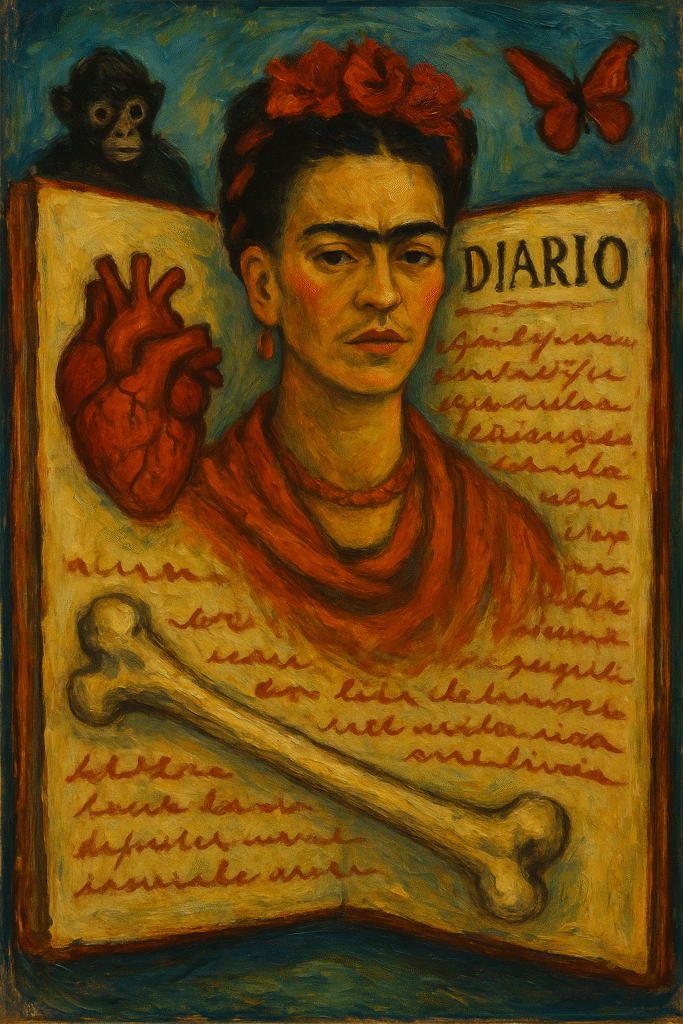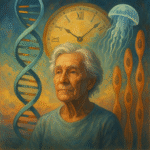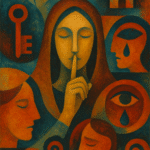Frida Kahlo (1907-1954), a distinguished Mexican painter, has left an indelible mark on the world of art with her unique narrative style and deeply personal subject matter. Her artworks, vividly colorful yet brimming with emotional complexity, often reflect her tumultuous life marked by physical suffering, emotional strife, and an unyielding quest for self-identity. However, to gain deeper insights into her experience of pain and her artistic output, one must delve into her diaries.
While Kahlo’s paintings captured moments of her suffering, it is her diaries that offer a more granular perspective on her internal life. These written reflections deepen our understanding of her art and symbolize multifaceted experiences of pain, trauma, and resilience. This analysis seeks to explore the contents of Kahlo’s diary, examining specific symbols of pain and their implications, alongside an understanding of how these differ from the symbols present in her visual art.
Overview of the Contents of Kahlo’s Diary
Kahlo began writing in her diary in 1944, a decade after she had started painting. This diary, filled with sketches, personal reflections, and remarks about her daily life, serves as a remarkable chronicle of her emotional landscape. The diary presents a mosaic of her life experiences—her physical suffering due to polio and a severe accident, her complex relationships, especially with her husband Diego Rivera, and her explorations of identity and femininity.
Kahlo’s diary is replete with vivid imagery and language that express not only her pain but also her moments of joy and defiance. The fragmented structure reflects her dynamic thought processes, shifting between poetry, prose, and visual art. It also reveals a more vulnerable side of Kahlo, one that stands in contrast to the bold, confident figures represented in her paintings. The symbols scattered throughout the diary often articulate her struggles in ways that her art might not fully encapsulate, providing an essential context for her creative expression.
Analysis of Specific Symbols of Pain Found in the Diary
As one delves into Kahlo’s diary, several recurring symbols emerge that depict pain:
1. Bones and Limbs
Kahlo frequently refers to her body, particularly her bones and limbs, as symbols of her suffering. In one poignant entry, she describes her feelings about her physical ailments, stating, “My body is a graveyard of broken bones.” This raw metaphor illustrates not only the physical manifestation of her pain but also evokes feelings of loss and absence, reminiscent of an artist who has been stripped of her agency. This theme highlights how her trauma is embedded in her identity and self-expression.
2. Animals
Kahlo often incorporated animals in her entries, notably in sketches and doodles. For instance, she writes about monkeys, which symbolize her childhood and innocence lost, but also a longing for companionship amidst solitude. Similarly, the imagery of the lion can represent her fierce spirit battling against the trials she faced, encompassing her emotional anguish. The juxtaposition of these creatures against her pain exemplifies how Kahlo sought affirmation of her self-worth amid adversity.
3. Blood
The symbol of blood appears throughout her diary, often described in relation to her physical wounds and the emotional toll they take on her psyche. In one entry, she writes, “Blood is life, and life has betrayed me.” This striking phrase not only underscores her existential realization about pain and survival but also evokes a meditation on her whole existence. Blood serves as both a literal and metaphorical representation of suffering—an indicator of the emotional scars that run deep in her being.
4. Nature
Nature, including elements like flowers and landscapes, paints a complex picture in Kahlo’s diary. While flowers are traditionally symbols of beauty and femininity, Kahlo often writes about them in the context of decay and grief. For instance, she notes, “The flowers wilt as I suffer.” This contradiction—where beauty simultaneously signifies pain—exemplifies her struggle with dualism, embodying both life and death, creation and destruction.
Discussion of Symbols Not Depicted in Her Canvases
While Kahlo’s paintings are rich with symbolism, several aspects of her emotional turmoil documented in her diary never made it to her canvases.
1. Intimate Thoughts on Loss
Kahlo repeatedly discusses losses she has endured, such as her miscarriages and the pain of losing her identity in relationships. These intimate reflections reveal a layer of vulnerability rarely expressed in her more public-facing art. The full extent of her solitude and yearning for connection is more articulated in her writings, suggesting that some of her emotional complexity was filtered out of her visual representations.
2. Psychological Illness
In her diaries, Kahlo reflects on her mental health struggles, capturing feelings of despair and existential dread that are less overt in her paintings. For instance, her notation on feeling like a “dispossessed spirit” illustrates a profound sense of alienation. This psychological facet offers a lens through which viewers can understand her work beyond the physical pain that often overshadows it. Kahlo’s candid discussions of mental anguish deepen the dialogue around her art, urging viewers to look beyond the canvases.
3. Existential Querying
Throughout her diary, Kahlo questions her existence, grappling with themes such as identity and purpose more directly than she does in her visual art. Her writings often reflect on whether her suffering is central to her artistic identity. The internal conflicts manifest as ink stains across the pages, each representing a deliberation about her worth as an artist—an exploration that does not directly translate into her visual narratives. This leads to an understanding that art is not just a reflection of her suffering but also a complex confrontation with the question of her identity and essence.
Conclusion
Exploring Frida Kahlo’s diary offers rich insights into her emotional intricacies, revealing symbols of pain that diverge from the narratives presented in her paintings. The symbols of bones, animals, blood, and nature found in her writings speak to a deeper understanding of her struggles. The diary serves as a critical document that highlights not only her physical suffering but also elicits broader discussions of identity, trauma, and psychological complexity.
As we absorb the layers of Kahlo’s experiences through her diary, we gain a fuller appreciation for her artistic vision. Each symbol of pain documented reflects a part of her story, enriching our interpretation of her artwork while emphasizing the power of personal expression in art. This duality—as artist and individual wrestling with suffering—leads us to acknowledge that every brushstroke contributes to a narrative colored by both beauty and grief. Understanding these intricate symbols deepens our engagement with Kahlo’s work, allowing her legacy to resonate profoundly within our contemporary consciousness.
FAQ Section
1. What is the significance of Frida Kahlo’s diary?
Frida Kahlo’s diary is significant as it provides an intimate glimpse into her thoughts, struggles, and emotional complexities. It reveals layers of her personality that complement her paintings and enrich our understanding of her artistic output.
2. How do the symbols in Kahlo’s diary compare with those in her paintings?
The symbols in Kahlo’s diary often delve deeper into the psychological and emotional aspects of her pain, illustrating themes of loss, isolation, and mental health. In contrast, her paintings tend to encode these experiences into visual narratives that are often more public-facing and symbolically layered.
3. What themes of pain are prevalent in Kahlo’s diary?
Themes of physical suffering, psychological anguish, loss, identity, and existential questioning dominate Kahlo’s diary. These themes showcase her struggles with both external circumstances and internal dilemmas.
4. How does examining Kahlo’s diary alter our understanding of her artwork?
Examining Kahlo’s diary offers a richer, more nuanced understanding of her artwork by revealing the raw emotions and struggles that shaped her artistic expressions. The knowledge of her internal conflicts can lead to a more profound appreciation and interpretation of her paintings.
5. What can we learn about the role of personal diaries for artists?
Personal diaries can serve as crucial tools for self-reflection and emotional expression for artists. They often reveal insights into their creative process and psychological landscape, contributing to a broader understanding of their artwork and personal journeys.


